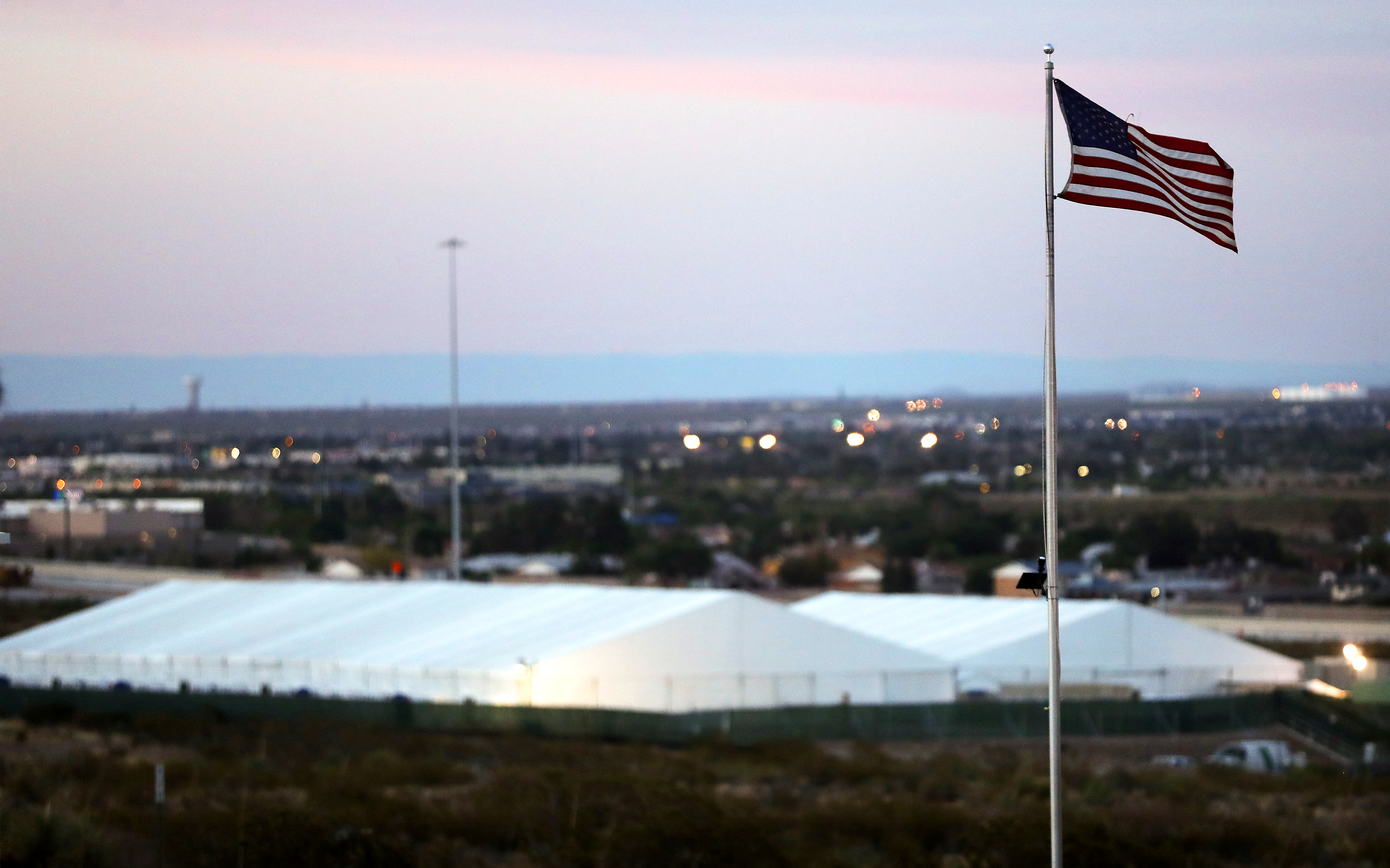What you need to know about: Tent cities at the border
Thousands of migrants in detention are suffering, and immigration officials are overwhelmed

Thousands of migrants in detention are suffering, and immigration officials are overwhelmed. Here's everything you need to know:
What's happening at the border?
Record numbers of Central American families fleeing gang violence and extreme poverty in Guatemala, Honduras, and El Salvador have overwhelmed U.S. immigration authorities, who are now erecting new tent cities to house thousands of people awaiting hearings on their applications for asylum. Immigration agents detained or turned away 109,144 people at the border in April, a 5.2 percent increase from March and the highest level of arrests since 2007. In the past, most illegal immigrants were single adults, mainly from Mexico, who were trying to cross the border to find work. Officials were able to process and deport most of the people arrested at the border within hours. But more than 60 percent of the predominantly Central American migrants taken into custody in April were families and children, the highest percentage ever. Instead of trying to sneak into the U.S., many of the migrants are turning themselves in and claiming asylum. Under U.S. law, anyone who steps foot on U.S. soil has the right to apply for asylum from persecution back home.
The Week
Escape your echo chamber. Get the facts behind the news, plus analysis from multiple perspectives.

Sign up for The Week's Free Newsletters
From our morning news briefing to a weekly Good News Newsletter, get the best of The Week delivered directly to your inbox.
From our morning news briefing to a weekly Good News Newsletter, get the best of The Week delivered directly to your inbox.
Why are officials overwhelmed?
America's border facilities weren't designed to deal with a large-scale refugee crisis. Overcrowding has forced the Border Patrol to improvise, converting strip malls and department stores into shelters and building military-style tent cities in parking lots. In March, hundreds of families were temporarily crowded into a makeshift holding pen underneath a highway overpass in El Paso, Texas. Photos of children hemmed in by razor wire and sleeping on gravel sparked widespread outrage.
What are the conditions?
Most of the holding cells in Border Patrol stations, designed to house migrants for just 12 hours, contain only a sink and a toilet; there are no beds. Migrants have nicknamed the frigid cells las hieleras, Spanish for "the iceboxes." Many migrants arrive sick after the grueling journey north. Four children have died since December after being detained at the border. "They took us to a room that was cold and gave us aluminum blankets," a Guatemalan woman held in an Arizona detention center in 2017 told Human Rights Watch. "There were no mats. We slept on the bare floor. It was cold, really cold."
A free daily email with the biggest news stories of the day – and the best features from TheWeek.com
What is the plan to respond?
The U.S. military plans to build at least six new tent cities along the border that should be better equipped to deal with migrant families. The new tents will be climate controlled, with bathrooms and recreation areas as well as sleeping mats. They will be able to house 7,500 people and will be operated by ICE, not the military. But John Morris, acting deputy chief patrol agent, told NBCNews.com that the new camps are a "Band-Aid" on an overwhelming problem. "This is a border security crisis and a policy crisis," Morris said. So far, the White House's policy has been to make applying for asylum as hard and unpleasant as possible.
How so?
Under the Trump administration's short-lived "zero tolerance" policy in 2018, at least 2,800 children were separated from their parents, who were kept in detention centers or federal jails. It took months to reunite many of those families after President Trump reversed the policy in the face of public pressure; hundreds of families were never reunited. A court-ordered internal investigation has revealed that at least another 1,700 families may have been separated, and immigration advocates say border officials are now taking children away from parents who have a record of nonviolent crimes, such as drunk driving, from many years earlier. The administration is also limiting the number of people who can apply for asylum at ports of entry each day, a policy called "metering." Some migrants are also being forced to wait in Mexico for their asylum hearings.
What else is being done?
Homeland Security recently issued guidelines telling immigration officials to take a tougher stance in screening interviews. Roughly 80 percent of asylum applicants pass their initial "credible fear" screening and are given a court date. Roughly 20 percent of applicants are ultimately approved. Because U.S. law prohibits families from being detained for more than 20 days, most are released into the country to await their asylum hearings. But the Trump administration is loath to release anyone it doesn't have to, fearing migrants won't return for their court dates. Attorney General William Barr recently ruled that adult asylum seekers can be held in detention indefinitely, adding to the problem of overcrowding in federal detention centers. It would take the current number of immigration judges about four years to work through the current backlog of nearly 900,000 asylum cases. David Lapan, a former Trump administration official in the Department of Homeland Security, said that current policies simply are not working. "Despite all the things the administration has done — send the military, separate families, the ‘Remain in Mexico' plan — the numbers are going up, not down," Lapan said.
The status of the wall
President Trump still believes a massive border wall will scare migrants away from trying to enter the U.S. The Pentagon plans to shift funds to build more border fencing, including $1.5 billion meant for the Afghanistan War and other programs, including an intercontinental ballistic missile defense program. The Defense Department has amassed funding for 256 miles of additional barriers, with plans to build about 63 miles over the next six months. A group of border communities and the Sierra Club have sued to halt those plans. In recent meetings with Homeland Security officials and military engineers, Trump reportedly stated that the wall should be painted black so that it absorbs sunshine, making it too hot to climb, with sharp spikes at the top. Critics say the wall will do nothing to stop migrants from coming north and legally applying for asylum at the border, because it doesn't address the underlying issue of lawlessness and gang violence in Central America. "You can't be any tougher on the border than what these people are facing at home," said Gil Kerlikowske, a former Customs and Border Protection commissioner.
-
 ‘Let 2026 be a year of reckoning’
‘Let 2026 be a year of reckoning’Instant Opinion Opinion, comment and editorials of the day
-
 Why is Iran facing its biggest protests in years?
Why is Iran facing its biggest protests in years?TODAY’S BIG QUESTION Iranians are taking to the streets as a growing movement of civic unrest threatens a fragile stability
-
 How prediction markets have spread to politics
How prediction markets have spread to politicsThe explainer Everything’s a gamble
-
 Bari Weiss’ ‘60 Minutes’ scandal is about more than one report
Bari Weiss’ ‘60 Minutes’ scandal is about more than one reportIN THE SPOTLIGHT By blocking an approved segment on a controversial prison holding US deportees in El Salvador, the editor-in-chief of CBS News has become the main story
-
 Has Zohran Mamdani shown the Democrats how to win again?
Has Zohran Mamdani shown the Democrats how to win again?Today’s Big Question New York City mayoral election touted as victory for left-wing populists but moderate centrist wins elsewhere present more complex path for Democratic Party
-
 Millions turn out for anti-Trump ‘No Kings’ rallies
Millions turn out for anti-Trump ‘No Kings’ ralliesSpeed Read An estimated 7 million people participated, 2 million more than at the first ‘No Kings’ protest in June
-
 Ghislaine Maxwell: angling for a Trump pardon
Ghislaine Maxwell: angling for a Trump pardonTalking Point Convicted sex trafficker's testimony could shed new light on president's links to Jeffrey Epstein
-
 The last words and final moments of 40 presidents
The last words and final moments of 40 presidentsThe Explainer Some are eloquent quotes worthy of the holders of the highest office in the nation, and others... aren't
-
 The JFK files: the truth at last?
The JFK files: the truth at last?In The Spotlight More than 64,000 previously classified documents relating the 1963 assassination of John F. Kennedy have been released by the Trump administration
-
 'Seriously, not literally': how should the world take Donald Trump?
'Seriously, not literally': how should the world take Donald Trump?Today's big question White House rhetoric and reality look likely to become increasingly blurred
-
 Will Trump's 'madman' strategy pay off?
Will Trump's 'madman' strategy pay off?Today's Big Question Incoming US president likes to seem unpredictable but, this time round, world leaders could be wise to his playbook